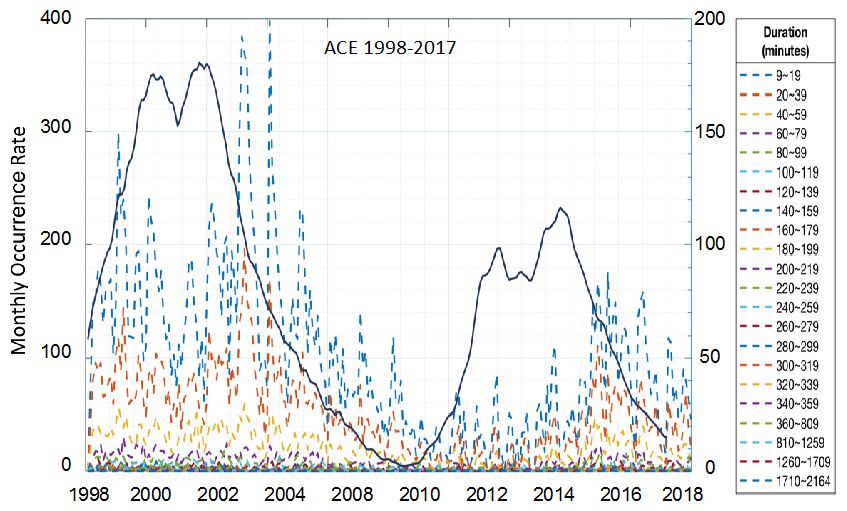Database of Small-Scale Magnetic Flux Ropes from ACE In-situ Measurements
PDF version

Figure 1: Monthly counts of small-scale flux ropes from 1998 to 2017. The dashed lines represent counts of duration occurrence, as noted at right. The smoothed monthly sunspot number (solid line) is the courtesy of SILSO, Royal Observatory of Belgium, Brussels.
Quantitative modeling and analysis of small-scale magnetic flux ropes from in-situ spacecraft data is essential for better understanding how they originate and interact with other space plasma structures. A small-scale magnetic flux-rope database has been built from 1998-2017 ACE/MAG and SWEPAM data utilizing the Grad-Shafranov (GS) reconstruction technique (http://www.fluxrope.info/).
Following Hu et al. [2018], automated detection of small-scale magnetic flux ropes was carried out on ACE datasets. Since the standard GS equation guarantees the transverse pressure Pt is a single-variable function of the magnetic flux function A, representing the flux-rope cross section, flux-ropes can be detected by evaluating Pt vs. A curves along the spacecraft path. First, we use multiple sliding windows starting each year to search for possible flux ropes of 9 minutes to 36 hours duration. All measurements are transformed to the quasi-static frame, usually the deHoffmann-Teller (HT) frame, to utilize the GS equation which assumes 2D magnetohydrostatic equilibrium.
After establishing the new frame, we use the inflection point of one field component to split the spacecraft path into two branches. Values of Pt and A are calculated and two Pt vs. A curves are compared to see if a double-folding (or overlapping) pattern exists. Difference and fitting residues are used to check pattern quality. In addition, we use the Walén slope, the ratio of the remaining flow velocity to the local Alfvén velocity, to exclude strong Alfvénic structures. A minimum field of 5 nT eliminates events with small solar wind fluctuations.
A total of 48,902 small-scale flux ropes were detected: 35,527 for Cycle 23 (1998-2008) and 13,375 for Cycle 24 (2009-2017). Figure 1 shows monthly counts and solar activity dependence. The database website lists basic information for each flux rope event (containing time range, duration, residue, average parameters including magnetic field, plasma beta, solar wind speed, proton temperature and axial orientation angles). For each single event, Pt vs. A curves (used to check double-folding quality), hodograms from minimum variance analysis with magnetic-field components converted to Alfvén-velocity components, and a Walén test plot are presented, as well as time-series magnetic field, solar wind velocity and plasma parameters (beta, proton number density, temperature).
This item was contributed by Yu Chen, Qiang Hu, and J. le Roux, Department of Space Science (SPA) and CSPAR at The University of Alabama, Huntsville (UAH). We thank the ACE/MAG and SWEPAM instrument teams, and ACE Science Center for data access. The automated flux rope search algorithm is implemented on the in-house cluster system, Bladerunner, at CSPAR/UAH. Address questions and comments to
ACE News Archives
Subscribe to ACE News
ACE Homepage
Last modified 03 Feb 2019.